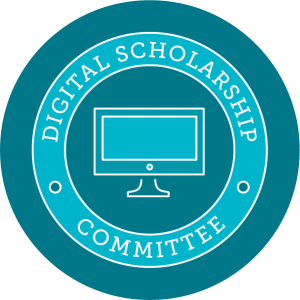For this DSC Guide Deep Dive, we’re kicking off Pride month by highlighting three notable online projects and resources from Digital Pedagogy in the Humanities related to the LGBTQIA+ community!
Coming of Age
https://philome.la/UMDAnnaD/trans-story-final/play/index.html
This autobiographical Twine story written by Anna Dennis (pronouns: she/her/hers) describes her experience as a trans youth. Anna begins Coming of Age by asking if you are cisgender or transgender because she has created two versions of this retelling of her youth.
![This image is of the home screen of Anna D's Coming of Age Twine story. This is a white screen with black text in the center and hooked arrows on the left side of the screen beside the text. The text reads: "Welcome to coming of age. I would first like to ask you however, are you cisgender [there is a link for cisgender] or are you transgender [there is a link for transgender]? I ask because for cisgender people, I would like this game to be an empathy game, to put you in the shoes of what it's like to be trans, and to help you understand why accurate advocacy on our behalf is vital. For trans people, I want this to be a positive experience for you. I want you to see my journey, and how far I've come from. I don't want you leaving this game feeling like it's hopeless to continue. I want this game for you to be a window into my life, and to learn from my mistakes, and just to see the same experience from a different pair of eyes. I love looking at other trans narratives because it feels nice to see my story told elsewhere, and I hope that this can provide you with that same experience."](https://blogs.library.unt.edu/digital-scholarship/wp-content/uploads/sites/20/2021/06/Coming-of-Age-by-Anna-D-Home-Screen-1-e1622816830260.png)
The home screen of Anna D’s Coming of Age Twine story.
No matter which gender identity you select, the author includes trigger warnings before you begin the story. Trigger warnings include gender dysphoria, self-harm, suicide, and suicide ideation, drug use, and explicit language. This informative look at one trans woman’s experience can be particularly useful for cisgender allies.
If Twine interests you, or you want to create your own story, you can find more information about Twine in our Digital Scholarship Guide under Tools and Resources.
Queer Literature and Film
https://queerlitfilm.wordpress.com/teaching-projects-and-tools/
Posted in 2013, Queer Literature and Film contains teaching materials and topics in LGBTQ+ literature and film. There are four syllabi available on this WordPress: Trans of Color, a 4-week course; The Literary History of Sex, a 10-week course; Heteronormativity and Queer Identity, a 2-week course; and Bisexuality, a 2-week course.
What makes these resources notable is their inclusion of courses centered around marginalized voices within the community such as transgender people of color and bisexual individuals. Furthermore, those seeking resources centered around queer and trans narratives, or wanting to know more about queer theory, transnational queer theory, Indigenous queer theory, and queer diasporas, may find the bibliographies within this WordPress a useful starting point. Please note that some materials in these courses may be triggering.
These courses are appropriate for high school and undergraduate-level students and serve as a starting point for those searching for LGBTQ+ films and literature.
Queer Music History 101
http://www.qmh101.com/
Queer Music History 101: A Special Project of Queer Music Heritage is a course website and special project created by J.D. Doyle with lessons for LGBT Studies courses. Don’t be deterred by the early internet look of this website! Queer Music History 101, which is part of Queer Music Heritage, contains a comprehensive history of LGBTQ+ music in two parts, 1926-1977 and 1973-1985, while functioning as a self-paced online course featuring audio, playlists, interviews, and videos. Doyle also provides notes and background information pertaining to each song and artist to guide users through the materials with appropriate context.
![This image is of the home screen of Queer Music History 101. The background is light yellow and at the top of the page is an image of a composition book with the text Queer Music History 101 written in the white space of the book. Beneath this image is purple text with the following text: Website Version: Lesson, Part 1, 1926-1977, below Lesson, Part 2 1973-1985 [Link to material], Recommended Books, and Notes [Link to material]". Beneath this text are four images in a row. The first image is of a record, black with white text over it Click to Stream part 1. The second image is of an upside down pink triangle with a black background with white text over it "Click to download Part 1". The third image is of a black record with white text "Click to Stream Part 2". The final image is of an upside down pink triangle with a black background with white text "Click to Download Part 2".](https://blogs.library.unt.edu/digital-scholarship/wp-content/uploads/sites/20/2021/06/Queer-Music-History-101-Homepage-1024x558.png)
Home screen of Queer Music History 101 created by J.D. Doyle.
Queer Music History 101 is available as both a website and a PDF. For those wanting more information about Queer Music History 101, Doyle provides notes regarding the course structure, style, copyright, along with recommended books and websites to enable further research.
Digital Pedagogy in the Humanities consists of scholarly, peer-reviewed materials and archived pedagogy sorted into collections. Each keyword is curated by scholars and contains a curatorial statement addressing the materials included in the collection. For more resources and pedagogy pertaining to the LGBTQ+ community, visit the following links from Digital Pedagogy.
Please take care when reading through the materials located in these collections as there may be triggering content.
- Intersectionality https://digitalpedagogy.hcommons.org/keyword/Intersectionality/
- Queer
https://digitalpedagogy.hcommons.org/keyword/Queer/ - Sexuality
https://digitalpedagogy.hcommons.org/keyword/Sexuality/
Visit the Women’s and Gender Studies department for more information about LGBT Studies, and don’t forget to check out UNT Pride Alliance for even more resources, scholarship opportunities, and programs!
Happy Pride Month!



Leave a Reply